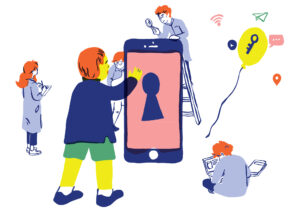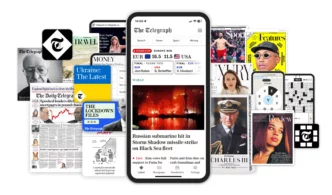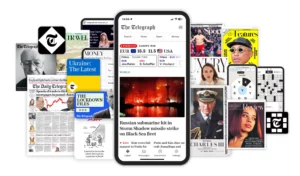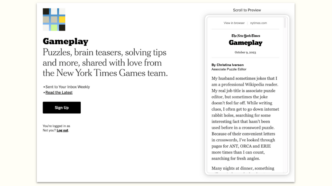
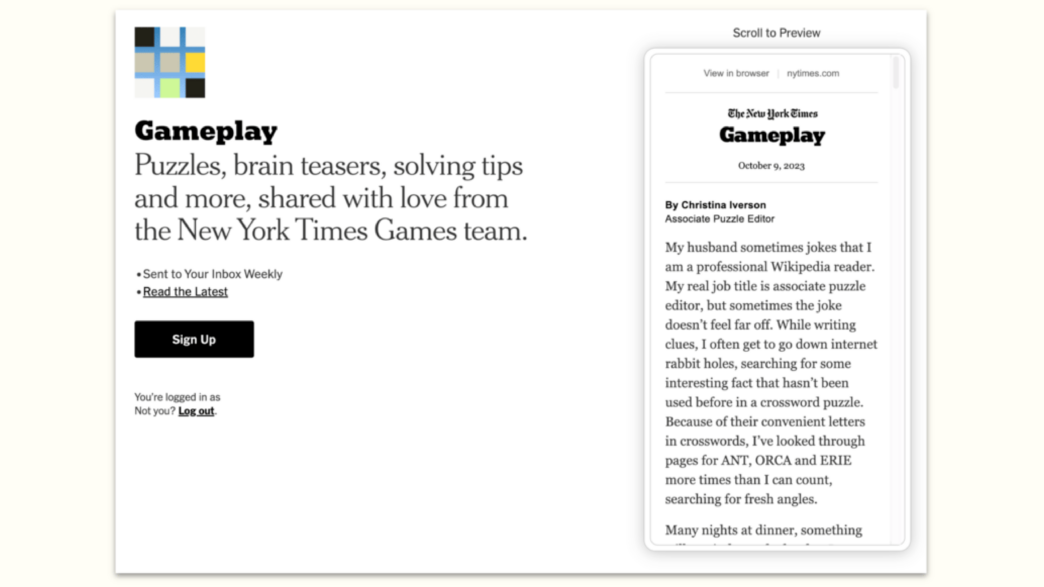
The playful evolution of media: Bridging games, newsletters and engagement
Emerging at the crossroads of leisure and information, media companies are increasingly recognizing the potential of games.
One of the most significant tales of this trend is the acquisition of Wordle by The New York Times, transforming a simple gesture of love into a global phenomenon.
And as media companies become more and more about newsletters, and the art of engagement becomes more paramount in the digital age, there is a convergence of newsletters + media companies + games.
Let’s dive in to one of the largest media companies around — The New York Times — and how they incorporate games into their newsletter strategy to captivate and engage their audience.
The New York Times and its games ventures
Let’s start with some context.
The acquisition of Wordle, born out of a romantic gesture, marked a significant moment in The New York Times’ approach to diversifying its content. Between 1942 (When The Crossword was first printed in The New York Times) and 2023, The New York Times has introduced a variety of new games, each captivating audiences in its own way.

They strive to “offer puzzles for all skill levels that everyone can enjoy playing every day,”
Their latest offering, “Connections,” has already garnered attention in the media world.
From the tactile pleasure of solving a crossword on print in 1942 to the digital satisfaction of receiving “Genius” status on Spelling Bee in 2023, it’s pretty wild.
The New York Times’ gaming ventures aim to engage, entertain, and, in many ways, educate. As we delve deeper, it becomes clear that games, just like news, have the power to shape narratives, form communities and stand the test of time.
> You’ll also enjoy: The New York Times dynamic paywall analyzed
Community building and engagement
In the realm of games, community isn’t just an afterthought.
Based on analysis from the Conversations Data Science team at Twitter, there were ~500,000 tweets per day about Wordle at one point.
The New York Times understands this dynamic, creating gaming content that not only entertains but also nurtures a sense of belonging. In recognizing the global nature of its audience, The New York Times’ crosswords group introduced their first word-free game: Tiles.
According to AdWeek in an article from Insider in 2019, it was created from the request of users. The Times Games Expansions team, “noticed that users were writing in late at night asking the company for a game that would help them zone out,”
The emergence of a dedicated “Games Twitter” and even spin-off accounts like “Not a Spelling Bee Word” exemplifies the vibrancy of The New York Times gaming community. Along with forums too.
The New York Times has created a hub for players to converse about strategies, share achievements and celebrate the essence of gaming. Moreover, including features like leaderboards which introduce a competitive edge, motivating players to refine their skills and deepen their involvement.
Speaking of competitive edge, how many of y’all had a Wordle Slack channel at one point?
Gameplay newsletter
A notable addition to The New York Times engagement initiatives is Gameplay, a newsletter specifically tailored for gaming enthusiasts.

Newsletter format
Typically, the newsletter follows this format:
- Introduction from the writer.
- A tease to a larger story: “Read more on Gameplay”.
- Wordle Weekly Recap, with a link to today’s Wordle.
- Brain Tickler, with the answer at the bottom of the newsletter.
- House ad. They’ve been featuring The Upshot.
- Spelling Bee puzzle with a link to play online. Also a shoutout to join today’s forum.
- A mention of the Crossword featuring one of the clues.
- Advertisement — but it appeared blank.
- Community Chatter with screenshots from various parts you can engage with The New York Times community (Twitter, comments, etc.).
- “Here’s More From Us” section with various Games stories.
- Footer section with options to subscribe to New York Times Games, the answer to the Brain Tickler and a CTA to sign up for Easy Mode — a newsletter where you can receive the “easy version” of one of the hardest crossword puzzles of the week.
When does gameplay send?
This weekly newsletter goes out in the morning, likely local time for the reader. You know… when you might most likely be gaming it up.
It may vary depending on if there is any Send Time Optimization or testing for when to send the newsletter going on.
Why a games newsletter?
There are likely a variety of reasons, and these are not confirmed by The New York Times, but here are some thought starters:
The New York Times leverages games like Wordle, not just as standalone products but as integral parts of their subscription and newsletter strategy.
Wordle was played more than 2 billion times in 2022, according to The New York Times.
Wordle and its companions aren’t just games; they’re engagement tools.
A win-win for both readers and The New York Times: while readers are entertained, The Times sees a financial upside (we’ll get more to that later).
By embedding games in other newsletters, the possibility of upselling or cross-selling other products becomes more palpable, especially when the user is engaged.
Here is an example of Spelling Bee being mentioned in the October 7 edition of The Morning, The New York Times’ flagship newsletter with over 17 million subscribers, according to NiemanLab.

There are also links to the news quiz, the Mini Crossword and other games.
Emails, specifically newsletters, can be more than information channels; they can be community hubs.

The New York Times’ gaming page and Gameplay newsletter encourage interactions, with readers sharing scores, discussing strategies and maybe even providing feedback on games.
By offering insights from the creators or puzzle editors along with gaming news, further establishes The New York Times as a trusted voice in the gaming sphere.

This specialized content, combined with an engaged community, creates a dynamic ecosystem.
Readers might arrive for Wordle but are introduced to a universe of content, keeping them informed, entertained, and, most importantly, engaged.
Financial aspects and strategy
The New York Times’ strategic evolution showcases its transition from traditional journalism to a multifaceted digital platform.
New York Times Cooking, the acquisition of The Athletic and the establishment of a dedicated gaming section are all reflections of this broader vision.
“We believe continued strong execution of our bundle strategy positions us to be more resilient to external market dynamics while driving sustainable value creation. We are proud of the progress we are making to build a larger and more profitable company, which in turn allows us to continue to do the most ambitious, high quality journalism across an ever broadening range of topics and formats.”
Meredith Kopit Levien, The New York Times President and CEO, mentioned in the second-quarter 2023 press release
It was reported that there were ~3.3 million bundle and multi-product subscribers in the second quarter of 2023.
Historical context on pricing
In a strategic shift in 2011, The New York Times, heeding the changing tides of the digital era, boldly introduced its paywall. The move, initially viewed with skepticism given the prevalent culture of free digital content, proved to be a game-changer.
By the years 2017-2018, their digital-only subscription revenues increased by 18% YoY, reaching $401 million. CNN, in 2020, reported their decision to increase this subscription price for the first time. The increase, 13%, took it from $15 to $17 every four weeks.
Current subscription landscape

In Q2 2023, The New York Times reported 9.88 million subscribers across print and digital products, including 9.19 digital-only subscribers, an increase from 8.41 million digital-only subscribers in Q2 2022.
An interesting observation, pointing to the reference in the Q2 2023 press release: More than a third of the nearly 10 million subscribers are bundle or multi-product subscribers.

If you try to sign up for New York Times Cooking individually, you’ll notice the push for All Access at the top, and having to scroll down to sign up only for New York Times Cooking.

Total revenue for the quarter was $590.9 million, a 6.3% YoY increase, with digital-only subscription revenues contributing a significant $269.8 million (a 13% YoY rise).
The 13% rise in digital subscription revenues during the second quarter was primarily attributed to a growing number of subscribers transitioning from introductory promotional prices to higher rates. Additionally, there were price increases implemented on tenured subscribers for digital news and Games, according to The New York Times.
The reported Average Revenue Per User (ARPU) for digital-only subscribers for Q2 2023 was $9.15.
When it comes to subscription choices, The New York Times offers some options:
- All Access: Includes News, Games, Cooking, Wirecutter and The Athletic. The current offer is $1/week for the first six months, and then $25 every four weeks. The first year total comes to $174.
- Individual subscriptions: Options include NYT Cooking at $1.25/week or $40/year and other product-specific subscriptions.

Notably, subscribing to New York Times Cooking, Games, Wirecutter and The Athletic individually would cost $153.88 for the first year, making it slightly cheaper than the All Access bundle priced at $174 for the same period.
It’s important to note that you wouldn’t have “News” access, but it doesn’t appear you can subscribe to just News based on their Digital Subscriptions FAQs page.
This pricing strategy raises a pertinent question: shouldn’t bundling offer better savings? Probably, but the only way to get access to News via subscription would be through the All Access bundle, placing a heavy emphasis on its value.
Additionally, these offers might be subject to variations based on promotional activities, purchase histories and more. Moreover, specific deals seem to target only new customers, excluding existing ones.
Another observation is that it appears the Basic Digital Access subscription is being phased out, and they’re pushing for everyone to have All Access since you would then be added to all of their products.
Looking ahead
From All Access to subscribing to specific products, The New York Times capitalizes on personalizing the reader experience. Newsletters play a pivotal role in this, likely segmenting audiences based on interests and ensuring the content (games included) aligns with what readers are most keen to engage with.
With the goal of hitting 15 million subscribers by 2027, The New York Times is ambitiously leveraging its pricing, product testing and diversification strategies.
Games in newsletters: strategy or trend?
As digital media continuously seeks innovative ways to capture and retain audience attention, the integration of games into newsletters emerges as more than a fleeting trend.
It’s a deliberate strategy aimed at fostering active engagement.
Newsletters aren’t merely opened — they’re oftentimes interacted with, transforming passive readers into actively engaged subscribers. And games adds to this immersive experience.
And it’s not just The New York Times diving into this territory. Other media outlets like The Washington Post have unveiled game-centric content such as their newsletter, Game Break, featuring Crossword, On the Record news quiz, and their brand-new game, Keyword.

Yet as more media houses delve into this realm, a critical question arises…
How impactful are games for these media companies?
An Axios report illuminates the topic further, highlighting that around “35% of the users who subscribe to the Times’ gaming subscription service now cite Wordle as the reason they subscribed,” as mentioned by Zoe Bell, executive producer at NY Times Games.
What makes this strategy particularly interesting is the feedback loop it creates. You may sign up specifically for Wordle, but then you might starting receiving the Gameplay newsletter, you then start playing Spelling Bee because of an article you read from the newsletter, and on and on.
In a nutshell, games may draw readers to the platform, then in turn the newsletters, and the newsletters enhance the gaming and content experience, leading to a, hopefully, more engaged and active subscriber.
This active engagement likely translates to higher retention rates, more opportunities for monetization and a more loyal subscriber base.
This creates a habit. And The New York Times seems to aim to be a part of your daily routine, and if it’s not reading the news, it’s playing the crossword, cooking a recipe, etc.
The growing significance of games in media
Games have always been a source of entertainment, but their role in today’s media landscape has grown.
Games was played almost 4 billion times in 2022 including The Mini Crossword, which was played more than 500 million times, according to The New York Times annual report.
Recognizing their potential as strategic tools, media giants like The New York Times have adeptly leveraged games for business growth, community engagement and revenue diversification.
The New York Times foray into this domain showcases the tangible benefits games bring to the media world:
- Acquisition and retention: Just one game can be a game-changer. Take Wordle, for instance. Its widespread popularity drew “tens of millions” to The New York Times, leading the media company to record its best quarter for net subscriber additions to Games.
- Revenue diversification: Games, with their potential to captivate millions, present a refreshing revenue stream. As The New York Times reports over 9 million digital-only subscribers, games stand out as a beacon, counterbalancing potentially stagnant advertising revenues.
- Enhanced engagement: The Wordle phenomenon wasn’t just a one hit wonder. Its ripple effect heightened interest in The New York Times’ broader gaming portfolio, subsequently likely boosting and enriching subscriber engagement levels.
Yet, the gaming pivot isn’t unique to The New York Times.
Other media contenders, like The Washington Post, Morning Brew, Vox and more, have too integrated game-inspired segments into their offerings — mainly newsletters.
This raises an intriguing question: Are these companies yielding results from games?
Wrapping up
The digital media landscape is ever-evolving, and the emergence of games within it is both fascinating and indicative of the industry’s resilience and adaptability.
Characterized not only by successes but also by the willingness to experiment.
For example: Digits. A pretty fun game based on numbers which was in beta but didn’t make it to the broader audience. This experimental approach underlines the company’s endeavor to innovate, even if every experiment doesn’t result in a widespread release.
This prototyping process was created by The Times’ Games Expansion team, launched in ~2017. It’s charter according to The New York Times is to: “create games that will challenge and delight Times readers in new ways for the next hundred years.”
With this in mind, looking back at the trajectory of the New York Times is pretty wild.
The New York Times was the last major metropolitan daily to offer a crossword ($), and now it has an entire team dedicated to Games. Once a latecomer to the crossword scene to now being at the forefront of digital gaming in journalism.
Yet, as media giants like The New York Times and others innovate, diversifying their offerings and blending the boundaries between news and entertainment, the question remains…
Is this a sustainable shift in digital journalism?
The success stories tied to games like Wordle not only reiterate the power of innovation but also underscore the potential of marrying traditional journalism with interactive media. Such a blend has proven to be a win-win, creating value for both media houses and their subscribers.
Other media giants, like The Washington Post and Morning Brew, are recognizing this potential and tailoring their offerings to resonate with a digitally-savvy, game-loving audience. As the trend gains traction, it will be interesting to witness how other media entities adapt, innovate, and, possibly, elevate the entire industry standard.
Will games remain a key player in the media’s toolkit? Or will they go back into the background as another innovation takes center stage?
Only time will reveal the full impact of this evolution. But for now, we can sit back, play a game of Wordle, and watch the story unfold.





